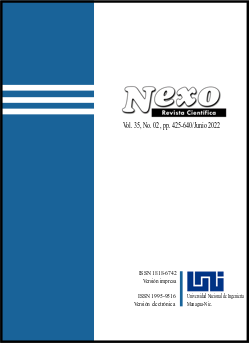Detection of thermal pollution of urban reservoirs using the method of IR-radiometry based on the example of the Lake Kenon, Zabaykalsky Krai
DOI:
https://doi.org/10.5377/nexo.v35i02.14629Keywords:
Thermal pollution, Urban reservoir, Infrared range, Lansat-8Abstract
Water bodies (e.g., rivers, lakes, and reservoirs) are an integral part of the urban environment. The infrastructure of the city affects their condition, in particular, pollution, including heat, which can lead to an increase in phyto- and zooplankton, including blue-green algae, and the appearance of toxins in the water. Identification of places where warm water is discharged into reservoirs is an urgent task. One of the methods of solving this problem is the monitoring of reservoirs from space. Thus, with the help of infrared satellite images, thermal anomalies are visible. In the work, we studied Lake Kenon located in the city of Chita. The satellite images were obtained from the Lansat-8. The channels used were 10 and 11, with a resolution of 60 meters. We revealed that (1) the optimal time for detecting thermal anomalies is the time before freezing in calm weather; (2) the cause of the thermal anomaly of this reservoir is a thermal power plant; (3) analysis of the last 5 years has shown that the water area with an increased surface temperature of the reservoir does not change; (4) the temperature gradient between cold and warm areas is 5°C; (5) the area of the heat spot does not exceed 10% of the total area of the lake. The above conclusions were confirmed using field measurements.
Downloads
Downloads
Published
How to Cite
Issue
Section
License
Copyright (c) 2022 Array

This work is licensed under a Creative Commons Attribution 4.0 International License.
The authors who publish in Nexo Scientific Journal agree to the following terms:
- Authors retain the copyright and grant the journal the right of the first publication under the license Creative Commons Attribution License https://creativecommons.org/licenses/by/3.0/, which allows others to share the work with a recognition of the authorship of the work and the initial publication in Nexo Scientific Journal.
- Authors may separately establish additional agreements for the non-exclusive distribution of the version of the work published in the journal (for example, in an institutional repository or a book), with the recognition of the initial publication in Nexo Scientific Journal.
- Authors are allowed and encouraged to disseminate their works electronically (for example, in institutional repositories or in their own website) before and during the submission process, as it can lead to productive exchanges, as well as earlier and greater citation of published works.











